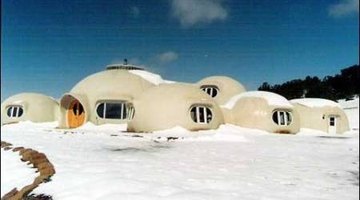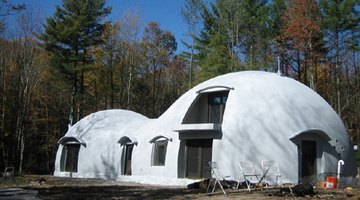Do it Yourself: Dome Houses
Dome houses are energy efficient, easy to build and environmentally friendly. When they are designed properly, domes can cost much less per square foot to build than the average home. Domes are naturally more resistant to weather and can survive hurricanes and tornadoes.

Design Stage

Decide on a type of dome to build. Several types of domes are available, but the most common are monolithic and geodesic. Monolithic takes more specialized equipment to construct, but the geodesic dome can be built with minimal tools and equipment. The monolithic dome is built by inflating a giant balloon, then layering the dome on the exterior of the shape. Once the shell is dry, the balloon can be deflated. This leaves a very smooth, round shape. A geodesic dome is built with long, straight bars, arranged in a way that puts the weight of the structure directly onto the struts. A monolithic dome is the stronger of the two. If one dome is not enough space, it can be enlarged, or several domes can be clustered together to increase the usable floor area. Domes of all types are so strong that they can be placed partially or completely underground, covered by local soil. The deeper into the ground the dome is placed, the more efficient it is to heat and cool.
Outer Covering Is Important

Determine the ideal outer shell covering for the climate. Some domes use space-age materials to cover the outer shell, while many use simple, standard house-building supplies such as wood and shingles. The covering should be easy to apply and watertight. With concrete, a popular shell material, sealants and smoothing can prevent cracking. Cracks and holes are the primary pitfalls of concrete and cement, and harsh weather or improper maintenance can create splits in a short amount of time. Monolithic domes will require a pour-on covering, but geodesics can be covered with flat panels.
Environment and Environmental Designs

Use environmentally friendly building techniques. Domes are efficient, and can be made even more so by using recycled or primary earth materials. Creating a round foundation out of used automotive tires, then filling the tires with a mixture of cement and local soil can make walls with outstanding strength and high insulation rating. Placement of vents and fans can make it unnecessary to run heaters and air conditioners, lowering energy usage. In multiple dome setups, localizing the water to one dome, while leaving the others plumbing-free, will save on materials and maintenance of the water systems. Domes make ideal homes, and building them can cost far less than standard frame houses.
References
Resources
Writer Bio
Eli Laurens is a ninth-grade physics teacher as well as a computer programmer and writer. He studied electrical engineering and architecture at Southern Polytechnic University in Marietta, Ga., and now lives in Colorado.
More Articles



